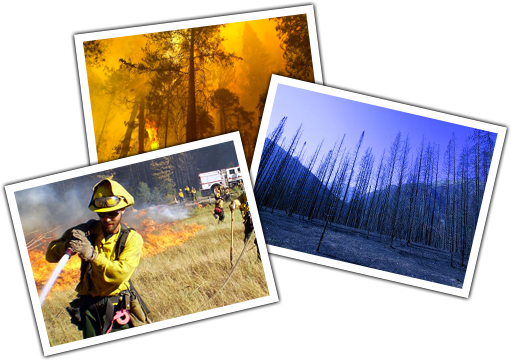The County's 'Shelter-in-Place' Gamble
SOURCE: UNION TRIBUNE:
By Joseph W. Mitchell
May 2, 2007
Twenty years before the Cedar fire roared through San Diego County, Australia was devastated by the Ash Wednesday fires, which destroyed 2,463 homes and killed 76 people. In the aftermath of this tragedy, the Australian fire services made an unprecedented and dramatic move: They abandoned their previous assurances to the public that they would always be there to protect them from catastrophic fires. Instead, homeowners in “the bush” would be responsible for the protection of their property. It is up to the homeowners to prepare – and even to defend – their own homes, while the fire services engage closely with the communities to teach them how.
The state of Victoria in southern Australia endured another horrendous fire season last winter. More than 3 million acres were burned in over 100 fires during a month-long siege. Yet, only 50 homes were lost, less than 2 percent of those threatened.
Today, the Australian fire services are seen as a model by our own county government as the county streamlines fire requirements including what it calls “Shelter-in-Place,” a plan that would allow development deep into high-risk fire areas. Under the county-approved plan, residents could be told to stay in their homes during a wildfire. If only the county had learned the full lesson from the Australian experience.
As part of a streamlining process, the county recently developed new policies for determining the significance of impacts of proposed developments judged against several criteria, including wildland fire risks. Over the protests of many, including ecologists, foresters, landscape architects and firefighters, new guidelines were approved that allow the fire services to permit construction even when secondary access for evacuation cannot be obtained. Instead, developers now can build using “ignition-resistant” construction materials, surrounded by cleared zones of up to 400 feet, where firefighters will supposedly defend the sheltering residents from the oncoming flames in the event of a wildfire.
The team of fire professionals that devised this plan claims to base it both on the Australian experience and its own. “Shelter-in-Place” has always been an option for firefighters to employ to protect the public, and they've used it effectively on many occasions, including the defense of Barona casino during the Cedar fire. This tactic, however, depends on the presence of firefighters.
What history has shown consistently in all catastrophic California wildfires is that firefighters are rapidly outflanked by wind-whipped fires and unable to reach many of those needing their aid. While clearance protects from flame and heat (100 feet would usually do just as well), scientific studies have shown that not even 400 feet will protect from the wind-driven blast of burning embers now widely acknowledged as responsible for most home ignitions.
Embers can penetrate into nooks and crannies, as evidenced by data collected by Amy and Oren Patashnik in Scripps Ranch, and recently presented at a scientific conference in a paper that we co-authored. This study shows that homes with curved-tile roofs are more likely to ignite than those with flat-tile roofs. Ignition-resistant construction is an advance that could address such problems, but this remains to be proven. This is because the data the county uses to support the safety of the current building code is flawed, as is all but a small fraction of fire data collected by fire services, which rely mostly on forensic analysis rather than controlled data collection.
The Australian approach is called “Stay & Defend or Go Early,” not “Shelter-in-Place.” It is supported by Australian and American research, which demonstrates that when people take measures to actively defend homes, the home survival odds improve tenfold.
While it sounds dangerous, fire self-defense can be carried out at low risk by those who have been properly trained with well-prepared homes. The Australian model relies on the fact that it takes over six times the radiant heat intensity to ignite a home than it does to kill a human. Properly dressed, people are resistant to the ember showers that destroy most homes. Homes and occupants symbiotically protect each other.
The Australian model also requires close cooperation between the fire services and all stakeholders. This key element is missing from the county's new policy. Many of those who commented on the proposed guidelines complained about lack of notice; requests for public hearings were refused. The allowance of Draconian clearance requirements, far beyond what is scientifically justified to create safety zones for firefighters who cannot be expected to arrive, creates a winner-take-all conflict in which either development is blocked or the backcountry devastated. Meanwhile, unprepared homeowners risk facing wildland fires alone in homes that are vulnerable because of construction, maintenance or design flaws while unaware of what to do during such an emergency.
While there are good things in the new county guidelines, they also demonstrate that our fire services are nowhere near surrendering their monopoly on wildland fire, or discouraging the public's unrealistic expectations regarding the level of protection they can count on. The real Australian lesson is that by going beyond the role of “team” and taking on the role of “coach,” fire services increase their effectiveness. Wildland fire is bigger than the fire services, but it is not bigger than all the backcountry stakeholders together.
SOURCE: UNION TRIBUNE: http://www.utsandiego.com/uniontrib/20070502/news_lz1e2mitchell.html

